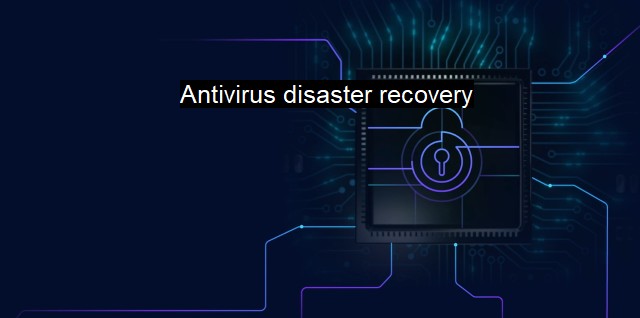What is Antivirus disaster recovery?
The Importance of Antivirus Disaster Recovery in Today's Cybersecurity Landscape: A Solution for Protecting Our Digital Devices
Antivirus disaster recovery is a vital process in the realm of cybersecurity and antivirus strategy. It refers to a systematic set of procedures that allows an organization to recover and control its processes and operations when a significant portion of its cybersecurity setup becomes affected by a widespread heterogeneous attack or virus, which overwhelmed the antivirus software in place. These viruses can disrupt regular operations, lead to the loss of data, or cripple an organization’s ability to function effectively. Thus, implementing disaster recovery measures is a crucial response to control, manage, and overcome such unforeseen disruptions.In a more broad context, Disaster recovery (DR) typically involves a set of policies, procedures, and implements to enable the recovery or continuation of vital technology infrastructure and systems following a natural or human-induced disaster. Antivirus disaster recovery has branched out in the DR strategy and focuses on adverse circumstances where infiltration by a virus has severe consequences.
In contemporary times, we reside in an era of incessant cyber activities, giving rise to multiple vulnerabilities and threats in terms of computer viruses, trojans, ransomware, and malware attacks. These malevolent programs are created by hackers intending to sabotage and throw off track the computer systems of organizations consequently hampering their functionality and process.
Here's where antivirus software comes into the picture as it monitors, detects, and eliminates these harmful elements to safeguard the organization's systems. no software is entirely invincible. Intruders continuously probe for software weaknesses, and during an unfortunate incident where the organisation's antivirus capacity is overwhelmed by a cyberattack leading to a complete shutdown or loss of crucial data, antivirus disaster recovery becomes pivotal.
Antivirus disaster recovery plans vary from organization to organization as they depend on the specific requirements and the nature of the organization's operations. some common features typically involve contingency actions in response to significant virus attacks. They include alternative arrangements to keep crucial operations up and running while software specialists or IT personnel work to eliminate the virus and recover the primary systems.
The primary focus of antivirus disaster recovery is data backup and retention. It ensures the data's integrity by safeguarding it through various means, such as hard back-ups, cloud storage, or using Disaster Recovery as a Service (DRaaS) providers. Regular data backup means that there is a copy of the information at hand, which can be restored post a cyber disaster, minimizing losses incurred due to a security breach.
Importantly, an antivirus disaster recovery protocol includes preventative measures. It takes into consideration the various possibilities of attacks and pre-empts safeguards to avoid the same. A robust plan also means regular audits and updates by diligently scanning for any signs of threats or weaknesses that the organization's systems can encounter consecutively helping to fortify defenses. For sensitive businesses, this proactive mechanism proves crucial as they can navigate quickly in the incident of a catastrophic failure or breakdowns owing to virus attacks.
The recovery strategy also comprises automated recovery processes that help to kick-start instant recovery when the system goes down sporadically due to virus attacks. The devised disaster recovery plan also provides a comprehensive framework towards rapid response and recovery from cyberattacks negating or minimizing business disruption.
An antivirus disaster recovery plan elevates a company's defense quotient against the incessant threat from cyberattacks and is, therefore, indispensable. It ensures continuance of business operations, customer trust, builds resilience, and protects the company's reputation during severe disruptions or breakdowns. Merely using security measures like antivirus is not enough in today's environment. Businesses need to engage a gear above these and invest more systematically in disaster recovery plans or mechanisms. In this way, they can ensure business continuance under all circumstances, galvanized recovery potential, and prepare effectively for any unforeseen eventualities.

Antivirus disaster recovery FAQs
What is antivirus disaster recovery?
Antivirus disaster recovery is the process of restoring antivirus systems and applications to their previous state after a disaster or cyber-attack. It involves recovering the important data and configurations of the antivirus software to prevent further damage to the system.What are the common causes of antivirus disasters?
The common causes of antivirus disasters include malware attacks, system crashes, hardware failure, human errors, and software glitches. These disasters can significantly impact cybersecurity and lead to data breaches, data loss, and other damaging consequences.What are the steps involved in antivirus disaster recovery?
The steps involved in antivirus disaster recovery include identifying the cause of the disaster, isolating the infected systems, scanning and cleaning the infected systems, restoring the antivirus configurations, and testing the antivirus software to ensure that it is functioning properly. Additional steps may be necessary depending on the nature and severity of the disaster.How can organizations prepare for antivirus disasters?
Organizations can prepare for antivirus disasters by implementing best practices such as updating antivirus software regularly, maintaining backup and recovery systems, training employees on cybersecurity, and testing antivirus disaster recovery plans regularly. Organizations can also work with cybersecurity experts to identify potential risks and develop customized disaster recovery plans.| | A | | | B | | | C | | | D | | | E | | | F | | | G | | | H | | | I | | | J | | | K | | | L | | | M | |
| | N | | | O | | | P | | | Q | | | R | | | S | | | T | | | U | | | V | | | W | | | X | | | Y | | | Z | |
| | 1 | | | 2 | | | 3 | | | 4 | | | 7 | | | 8 | | |||||||